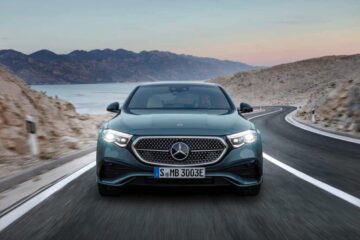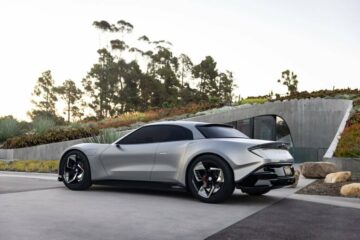For the first time in nearly two years, the average price paid for a new vehicle in the U.S. dropped below the number on the window sticker. Rising inventory levels and incentives combined to push the number down in March.

The average transaction price — what a consumer pays for a vehicle — fell to $48,008, according to Kelley Blue Book. That’s down 1.1%, or about $550, from February’s number of $48,558. However, it’s still $1,784 more than a year ago.
More importantly, the average price was $171 less than the average sticker price. In a time where some minivans are getting additional dealer markups, or ADMs, of several thousand dollars, the new number suggests a return to normalcy could be on the horizon.
There was an outlier: electric vehicles. The ATP for EVs was up $313, or 0.5%, KBB.com noted. While the average EV sold for $58,940, which is well above the overall average, even EVs can’t seem to defy market forces as pricing has been on the decline since the third quarter of last year.
Why the drop?

For starters, auto manufacturer’s incentive spend rose to the highest level in 12 months at 3.2% of the average transaction price, or ATP, in March 2023, averaging $1,516. Sales volumes were up month over month by 20% and up 8% year over year in March 2023, thanks partly to improved supply, a better mix of lower-priced models and strong fleet sales.
“The latest transaction data from March reveals new-vehicle prices continued a downward trend through the first quarter of 2023,” said Rebecca Rydzewski, research manager of economic and industry insights for Cox Automotive.
“Both luxury and non-luxury prices were down month over month. We’ve been anticipating transaction price declines, as inventory has been steadily improving and choice has expanded. More vehicles on dealer lots — and on their competitors’ lots — means dealers simply don’t have the pricing power they did six months ago.”
Prices were down across multiple segments, including non-luxury and luxury brands. The average price for a non-luxury vehicle was $44,182, a $505 slide compared to a year ago.

Most non-luxury brands, including Chevrolet, Chrysler, Dodge, Ford, Hyundai, Kia, Nissan and Volkswagen, saw ATP declines between 0.2% to 3.8% month over month in March. These drops are tied to higher incentives helping to push prices down. But not every brand saw prices below sticker in March as Honda and Kia pricing was between 3% and 6% over sticker price in March.
Comfort is king
Americans continue to show their love of luxury vehicles as the segment captured 18.2% of the total market. While its down from 19.3% in January, the total number is high compared to historical averages. The strong sales of luxury brands are aided by longer loan terms, which allow for lower monthly payments, and improved incentives.
The high share pushes the overall industry ATP higher, even though the luxury ATP has declined month over month. For comparison, in March 2018, the luxury share was 14% of the market. Two luxury brands — Land Rover and Porsche — now enjoy average transaction prices over $100,000.
Buyers continue to pay over sticker for new luxury vehicles. In March, the average luxury buyer paid $65,202 for a new vehicle, down just $9 from February 2023. Luxury vehicle ATPs were a mixed bag in March, with entry-level luxury cars, high-end luxury cars, luxury compact SUVs, luxury midsize SUVs and luxury subcompact SUVs all showing price declines between 0.5% and 1.4%. Luxury cars and luxury full-size SUVs saw price increases between 0.8% and 1.6%.
- SEO Powered Content & PR Distribution. Get Amplified Today.
- Platoblockchain. Web3 Metaverse Intelligence. Knowledge Amplified. Access Here.
- Source: https://www.thedetroitbureau.com/2023/04/end-of-a-trend-new-vehicle-prices-drop-below-sticker-in-march/
- :is
- $UP
- 000
- 1
- 12 months
- 2%
- 2018
- 2023
- a
- About
- above
- across
- Additional
- All
- and
- anticipating
- ARE
- AREA
- AS
- At
- auto
- automotive
- average
- bag
- BE
- below
- Better
- between
- Blue
- brand
- brands
- Buying
- by
- car
- cars
- Chevrolet
- choice
- chrysler
- COM
- combined
- compared
- comparison
- consumer
- continue
- continued
- could
- Cox
- data
- dealer
- Decline
- Declines
- DID
- Dodge
- dollars
- Dont
- down
- downward
- Drop
- dropped
- Drops
- Economic
- Electric
- electric vehicles
- enjoy
- entry-level
- especially
- EV
- Even
- Every
- expanded
- February
- First
- first time
- FLEET
- For
- Forces
- Ford
- from
- getting
- GM
- Have
- helping
- High
- High-End
- higher
- highest
- historical
- horizon
- However
- HTTPS
- Hyundai
- improved
- improving
- in
- Incentive
- Incentives
- Including
- Increases
- industry
- Industry Insights
- insights
- inventory
- ITS
- January
- jpg
- Kelley
- Kia
- Land
- land rover
- Last
- Last Year
- latest
- Level
- levels
- loan
- longer
- love
- Luxury
- manager
- March
- Market
- market forces
- max-width
- means
- mixed
- models
- Month
- monthly
- months
- more
- multiple
- nearly
- New
- Nissan
- noted
- number
- of
- on
- overall
- paid
- Pay
- payments
- pays
- plato
- Plato Data Intelligence
- PlatoData
- Porsche
- power
- price
- Prices
- pricing
- Push
- Quarter
- research
- return
- Reveals
- Rise
- rising
- ROSE
- rover
- s
- sales
- segment
- segments
- several
- Share
- show
- simply
- since
- SIX
- Six months
- Slide
- sold
- some
- spend
- starters
- Still
- strong
- Suggests
- supply
- SUVs
- terms
- The
- their
- These
- Third
- Through
- Tied
- time
- to
- Total
- transaction
- Trend
- u.s.
- vehicle
- Vehicles
- volkswagen
- volumes
- WELL
- What
- which
- while
- with
- year
- years
- zephyrnet










